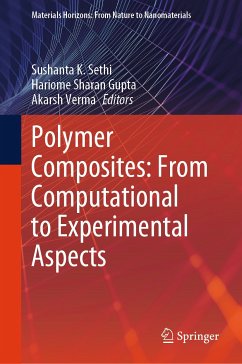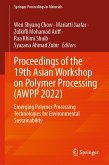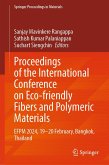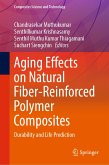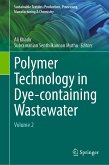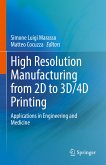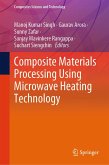Polymer Composites: From Computational to Experimental Aspects (eBook, PDF)
Redaktion: Sethi, Sushanta K.; Verma, Akarsh; Gupta, Hariome Sharan
129,95 €
129,95 €
inkl. MwSt.
Sofort per Download lieferbar

65 °P sammeln
129,95 €
Als Download kaufen

129,95 €
inkl. MwSt.
Sofort per Download lieferbar

65 °P sammeln
Jetzt verschenken
Alle Infos zum eBook verschenken
129,95 €
inkl. MwSt.
Sofort per Download lieferbar
Alle Infos zum eBook verschenken

65 °P sammeln
Polymer Composites: From Computational to Experimental Aspects (eBook, PDF)
Redaktion: Sethi, Sushanta K.; Verma, Akarsh; Gupta, Hariome Sharan
- Format: PDF
- Merkliste
- Auf die Merkliste
- Bewerten Bewerten
- Teilen
- Produkt teilen
- Produkterinnerung
- Produkterinnerung

Bitte loggen Sie sich zunächst in Ihr Kundenkonto ein oder registrieren Sie sich bei
bücher.de, um das eBook-Abo tolino select nutzen zu können.
Hier können Sie sich einloggen
Hier können Sie sich einloggen
Sie sind bereits eingeloggt. Klicken Sie auf 2. tolino select Abo, um fortzufahren.

Bitte loggen Sie sich zunächst in Ihr Kundenkonto ein oder registrieren Sie sich bei bücher.de, um das eBook-Abo tolino select nutzen zu können.
This book is intended to shed light on the computational modeling and experimental techniques that are used in the characterization of various polymer based composite materials. It covers mechanisms, salient features, formulations, important aspects, and case studies of polymer composite materials utilized for various applications. The latest research in this area as well as possible avenues of future research is also highlighted to encourage the researchers.
- Geräte: PC
- ohne Kopierschutz
- eBook Hilfe
- Größe: 10.58MB
Andere Kunden interessierten sich auch für
![Proceedings of the 19th Asian Workshop on Polymer Processing (AWPP 2022) (eBook, PDF) Proceedings of the 19th Asian Workshop on Polymer Processing (AWPP 2022) (eBook, PDF)]() Proceedings of the 19th Asian Workshop on Polymer Processing (AWPP 2022) (eBook, PDF)169,95 €
Proceedings of the 19th Asian Workshop on Polymer Processing (AWPP 2022) (eBook, PDF)169,95 €![Proceedings of the International Conference on Eco-friendly Fibers and Polymeric Materials (eBook, PDF) Proceedings of the International Conference on Eco-friendly Fibers and Polymeric Materials (eBook, PDF)]() Proceedings of the International Conference on Eco-friendly Fibers and Polymeric Materials (eBook, PDF)266,95 €
Proceedings of the International Conference on Eco-friendly Fibers and Polymeric Materials (eBook, PDF)266,95 €![Aging Effects on Natural Fiber-Reinforced Polymer Composites (eBook, PDF) Aging Effects on Natural Fiber-Reinforced Polymer Composites (eBook, PDF)]() Aging Effects on Natural Fiber-Reinforced Polymer Composites (eBook, PDF)137,95 €
Aging Effects on Natural Fiber-Reinforced Polymer Composites (eBook, PDF)137,95 €![Polymer Technology in Dye-containing Wastewater (eBook, PDF) Polymer Technology in Dye-containing Wastewater (eBook, PDF)]() Polymer Technology in Dye-containing Wastewater (eBook, PDF)65,95 €
Polymer Technology in Dye-containing Wastewater (eBook, PDF)65,95 €![High Resolution Manufacturing from 2D to 3D/4D Printing (eBook, PDF) High Resolution Manufacturing from 2D to 3D/4D Printing (eBook, PDF)]() High Resolution Manufacturing from 2D to 3D/4D Printing (eBook, PDF)113,95 €
High Resolution Manufacturing from 2D to 3D/4D Printing (eBook, PDF)113,95 €![Composite Materials Processing Using Microwave Heating Technology (eBook, PDF) Composite Materials Processing Using Microwave Heating Technology (eBook, PDF)]() Composite Materials Processing Using Microwave Heating Technology (eBook, PDF)121,95 €
Composite Materials Processing Using Microwave Heating Technology (eBook, PDF)121,95 €![The Engineer's Guide to Materials (eBook, PDF) The Engineer's Guide to Materials (eBook, PDF)]() K. T. VoiseyThe Engineer's Guide to Materials (eBook, PDF)61,95 €
K. T. VoiseyThe Engineer's Guide to Materials (eBook, PDF)61,95 €-
-
-
This book is intended to shed light on the computational modeling and experimental techniques that are used in the characterization of various polymer based composite materials. It covers mechanisms, salient features, formulations, important aspects, and case studies of polymer composite materials utilized for various applications. The latest research in this area as well as possible avenues of future research is also highlighted to encourage the researchers.
Dieser Download kann aus rechtlichen Gründen nur mit Rechnungsadresse in A, B, BG, CY, CZ, D, DK, EW, E, FIN, F, GR, HR, H, IRL, I, LT, L, LR, M, NL, PL, P, R, S, SLO, SK ausgeliefert werden.
Produktdetails
- Produktdetails
- Verlag: Springer Nature Singapore
- Seitenzahl: 412
- Erscheinungstermin: 29. April 2024
- Englisch
- ISBN-13: 9789819708888
- Artikelnr.: 70528906
- Verlag: Springer Nature Singapore
- Seitenzahl: 412
- Erscheinungstermin: 29. April 2024
- Englisch
- ISBN-13: 9789819708888
- Artikelnr.: 70528906
- Herstellerkennzeichnung Die Herstellerinformationen sind derzeit nicht verfügbar.
Prof. (Dr.) Sushanta Kumar Sethi is currently an Assistant Professor in the Department of Mechanical, Materials & Aerospace Engineering at IIT Dharwad since July 2023. Before this, Dr. Sethi worked as a Post-Doctoral Fellow in the Department of Metallurgical Engineering & Materials Science (MEMS) at IIT Bombay. In February 2021, he successfully completed his Ph.D. in the Department of Polymer & Process Engineering at IIT Roorkee. Dr. Sethi holds an M. Tech from IIT Kharagpur and a B. Tech in Mechanical Engineering from BPUT, Odisha. His research interests encompass various areas such as computational materials science, self-clean coatings, functional nanomaterials/quantum dots and their applications, multi-scale molecular modeling and simulations of polymer materials, development of novel and environmentally sustainable polymer composites and nanocomposites, as well as coatings and adhesives. Dr. Sethi has an impressive publication record with around 35 research publications in internationally recognized SCI journals, international conferences, and book chapters. He has made significant contributions to esteemed peer-reviewed journals in the field of Polymer engineering and science, ACS sensors, and Polymers, among others. His remarkable achievements include receiving the Best Doctoral Thesis Award for Polymer & Process Engineering from IIT Roorkee and recognition from the Science Technology Engineering and Management (STEM) society. Hariome Sharan Gupta is currently working in the Department of Polymer and Process Engineering, Indian Institute of Technology Roorkee (IITR) Saharanpur Campus, Paper Mill Road Saharanpur, India. He holds M.Tech. (IIT BHU, Varanasi) in Material Science Department and B.Tech. (CIPET, Lucknow) in Plastics Engineering Department. His research interests include polymer composites and polymer nanocomposites, adhesives and coatings, applications of additives, polymer and composites processing/compounding, predictions of polymer composites by models and 3 equations. He has several published and communicated research publications in international peer-reviewed SCI journals. Prof. (Dr.) Akarsh Verma is working as an Assistant Professor at the University of Petroleum and Energy Studies (India) and JSPS International Research Fellow at Osaka University (Japan). He obtained a Ph.D. in Mechanical Engineering from the Indian Institute of Technology Roorkee, India, and did his postdoctoral research work at Osaka University (Japan) and Brigham Young University (USA). His area of interest is computational mechanics, computational chemistry, quantum mechanics, molecular dynamics, nanocomposites, etc. He has been awarded various international fellowships/awards. Also, he has been recognized by Stanford University's list of the world's Top 2% of the Most-Cited Scientists in Single Year Citation Impact (2022, 2021 and 2020).
Chapter 1. Polymer composites: its processing, advantages, properties and their applications.-Chapter 2. Benefits of additives in Polymer composites.- Chapter 3. Different processing techniques used for Polymer Composites.- Chapter 4. The effect of various additives on the mechanical properties of ZrC Composites.- Chapter 5. Quick response of polymer composites to storage preservations of fruits and vegetables in supply chain.- Chapter 6. Applications of deep learning for composites materials.- Chapter 7. Types and Fabrications of polymer composites: overview.- Chapter 8. Different curing method used for polymer composites.- Chapter 9. Types of assembling and coatings used for polymer composites: overview.- Chapter 10. Nondestructive repairing of polymer composites.- Chapter 11. Short and micro cellulose based environmentally friendly polymer composites.- Chapter 12. Viscoelastic and thermomechanical properties of polymer composites.- Chapter. 13. Self-healing of polymer composites:process and developments.- Chapter 14. Polymer composites for environmental pollutions and remediations.- Chapter 15. Creep behaviors and fracture of natural fiber reinforced polymer composites.- Chapter 16. Natural and synthetic fiber reinforced polymer composites foams.- Chapter 17. Performance measurements and constructions applications of natural and synthetic fiber reinforced polymer composites.- Chapter 18. Rheological, thermal and mechanical properties of polymer composites.- Chapter 19. Morphological and spectroscopic study of polymer composites.- Chapter 20. Natural and synthetic fiber filled polymer composites used as anticorrosive materials.- Chapter 21. Fiber filled polymer composites used in fuel cell and solar energy applications.- Chapter 22. Mathematical modeling of short fiber reinforced polymer composites.- Chapter 23. Open mold and close mold processing of fiber filled polymer composites.- Chapter 24. Dielectrically properties of polymer composites under low and high electrical fields.- Chapter 25. Thermal stability and electrical insulations properties of polymer composites.
Chapter 1. Polymer composites: its processing, advantages, properties and their applications.-Chapter 2. Benefits of additives in Polymer composites.- Chapter 3. Different processing techniques used for Polymer Composites.- Chapter 4. The effect of various additives on the mechanical properties of ZrC Composites.- Chapter 5. Quick response of polymer composites to storage preservations of fruits and vegetables in supply chain.- Chapter 6. Applications of deep learning for composites materials.- Chapter 7. Types and Fabrications of polymer composites: overview.- Chapter 8. Different curing method used for polymer composites.- Chapter 9. Types of assembling and coatings used for polymer composites: overview.- Chapter 10. Nondestructive repairing of polymer composites.- Chapter 11. Short and micro cellulose based environmentally friendly polymer composites.- Chapter 12. Viscoelastic and thermomechanical properties of polymer composites.- Chapter. 13. Self-healing of polymer composites:process and developments.- Chapter 14. Polymer composites for environmental pollutions and remediations.- Chapter 15. Creep behaviors and fracture of natural fiber reinforced polymer composites.- Chapter 16. Natural and synthetic fiber reinforced polymer composites foams.- Chapter 17. Performance measurements and constructions applications of natural and synthetic fiber reinforced polymer composites.- Chapter 18. Rheological, thermal and mechanical properties of polymer composites.- Chapter 19. Morphological and spectroscopic study of polymer composites.- Chapter 20. Natural and synthetic fiber filled polymer composites used as anticorrosive materials.- Chapter 21. Fiber filled polymer composites used in fuel cell and solar energy applications.- Chapter 22. Mathematical modeling of short fiber reinforced polymer composites.- Chapter 23. Open mold and close mold processing of fiber filled polymer composites.- Chapter 24. Dielectrically properties of polymer composites under low and high electrical fields.- Chapter 25. Thermal stability and electrical insulations properties of polymer composites.
